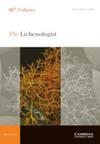木犀枝的奇特案例:没有人支持其区别
IF 1.4
4区 生物学
Q4 MYCOLOGY
引用次数: 2
摘要
木犀枝在化学变异方面表现出一种特殊的模式。其化学型与相关的分枝杆菌铊的化学型一致。这导致了各种假说的形成,但其真实性质从未得到澄清。我们在中欧和挪威采集了C.luteoalba。通过薄层色谱法检测其化学型,通过ITS rDNA的Sanger测序鉴定分枝杆菌和光生菌。获得分枝杆菌培养物,并针对铊内的次要分枝杆菌进行真菌ITS1 rDNA区域的Illumina代谢编码。没有一种方法支持C.luteoalba作为一种独特的枝孢属物种。在系统发育分析中,它被放在C.straminea和C.coccifera agg。,遵循化学模式。代谢编码或培养均未检测到小分枝杆菌。因此,C.luteoalba仍然是一个谜,因为我们的数据不支持它作为一个单独的Cladonia物种的区别。本文章由计算机程序翻译,如有差异,请以英文原文为准。
The curious case of Cladonia luteoalba: no support for its distinction
Cladonia luteoalba shows a specific pattern in chemical variability. Its chemotype coincides with that of the associated Cladonia thalli. This has led to the formation of various hypotheses, but its true nature has never been clarified. We collected C. luteoalba in Central Europe and Norway. The chemotypes were detected by TLC and the mycobionts and photobionts were identified by Sanger sequencing of ITS rDNA. Mycobiont cultures were obtained and Illumina metabarcoding of the fungal ITS1 rDNA region was performed targeting minor mycobionts within the thalli. None of the methods supported C. luteoalba as a distinct Cladonia species. In phylogenetic analyses, it was placed in C. straminea and the C. coccifera agg., following the pattern in chemistry. No minor Cladonia were detected by metabarcoding or cultivation. Thus, C. luteoalba remains enigmatic as our data did not support its distinction as a separate Cladonia species.
求助全文
通过发布文献求助,成功后即可免费获取论文全文。
去求助
来源期刊

Lichenologist
生物-真菌学
CiteScore
2.90
自引率
14.30%
发文量
23
审稿时长
6.0 months
期刊介绍:
The Lichenologist is the premier scientific journal devoted exclusively to the study of lichens worldwide. As the leading forum for the dissemination of new concepts and topical reviews, The Lichenologist reaches more scientists concerned with the study of lichens and lichen symbionts than any other single journal. All aspects of lichenology are considered including systematics and phylogenetics; molecular biology; ultrastructure, anatomy and morphology; secondary chemistry, effects of pollutants and use as bioindicators; biogeography. In addition to standard length research papers, the journal also publishes Short Communications and Book Reviews. A monthly issue may occasionally be devoted to papers deriving from a symposium.
 求助内容:
求助内容: 应助结果提醒方式:
应助结果提醒方式:


